GFSK Mod: Difference between revisions
Jump to navigation
Jump to search
(Add new parameter to the GFSK Mod block) |
(Add example flowgraph for GFSK Mod block) |
||
| Line 26: | Line 26: | ||
== Example Flowgraph == | == Example Flowgraph == | ||
The flowgraph below shows an example of the GFSK Mod and GFSK Demod blocks in action. We GFSK modulate 9-bit long bit stream '000111011', and then GFSK demodulate it. Then we compare the two bit streams to make sure that they are the same. | |||
[[File:Gfsk_mod_and_demod.png|800px]] | |||
When the flowgraph runs, we see that the red and blue signals are the same, meaning that the bit streams before and after the GFSK modulation and demodulation are the same. | |||
[[File:Gfsk_mod_and_demod_in_action.png|800px]] | |||
== Source Files == | == Source Files == | ||
Revision as of 14:46, 21 July 2021
Hierarchical block for Gaussian Frequency Shift Key (GFSK) modulation.
The input is a byte stream (unsigned char) and the output is the complex modulated signal at baseband.
Parameters
- Samples/Symbol
- Samples per baud >= 2 (integer)
- Sensitivity
- Given to the Frequency Mod
- BT
- Gaussian filter bandwidth * symbol time (float)
- Verbose
- Print information about modulator?
- Log
- Print modulation data to files?
- Unpack
- Unpack input byte stream?
Example Flowgraph
The flowgraph below shows an example of the GFSK Mod and GFSK Demod blocks in action. We GFSK modulate 9-bit long bit stream '000111011', and then GFSK demodulate it. Then we compare the two bit streams to make sure that they are the same.
When the flowgraph runs, we see that the red and blue signals are the same, meaning that the bit streams before and after the GFSK modulation and demodulation are the same.
Source Files
- Python files
- [1]
- Block definition
- [2]

